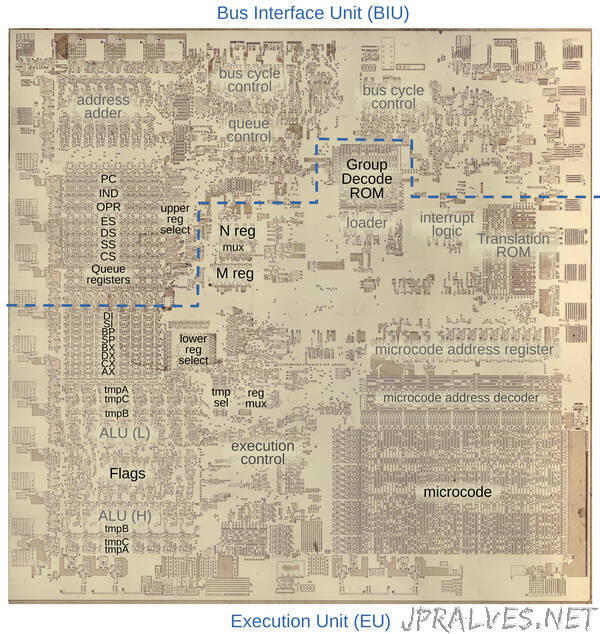
“Like most processors, the Intel 8086 (1978) provides registers that are faster than main memory. As well as the registers that are visible to the programmer, the 8086 has a handful of internal registers that are hidden from the user. Internally, the 8086 has a complicated scheme to select which register to use, with a combination of microcode and hardware. Registers are assigned a 5-bit identifying number, either from the machine instruction or from the microcode. In this blog post, I explain how this register system works.
My analysis is based on reverse-engineering the 8086 from die photos. The die photo below shows the chip under a microscope. For this die photo, I removed the the metal and polysilicon layers, revealing the silicon underneath. I’ve labeled the key functional blocks; the ones that are important to this post are darker. In particular, the registers and the Arithmetic/Logic Unit (ALU) are at the left and the microcode ROM is in the lower right. Architecturally, the chip is partitioned into a Bus Interface Unit (BIU) at the top and an Execution Unit (EU) below. The BIU handles bus and memory activity as well as instruction prefetching, while the Execution Unit (EU) executes the instructions.
Microcode
Most people think of machine instructions as the basic steps that a computer performs. However, many processors (including the 8086) have another layer of software underneath: microcode. With microcode, instead of building the control circuitry from complex logic gates, the control logic is largely replaced with code. To execute a machine instruction, the computer internally executes several simpler micro-instructions, specified by the microcode.
The 8086 uses a hybrid approach: although it uses microcode, much of the instruction functionality is implemented with gate logic. This approach removed duplication from the microcode and kept the microcode small enough for 1978 technology. In a sense, the microcode is parameterized. For instance, the microcode can specify a generic Arithmetic/Logic Unit (ALU) operation and a generic register. The gate logic examines the instruction to determine which specific operation to perform and the appropriate register.
A micro-instruction in the 8086 is encoded into 21 bits as shown below. Every micro-instruction has a move from a source register to a destination register, each specified with 5 bits; this encoding is the main topic of this blog post. The meaning of the remaining bits depends on the type field and can be anything from an ALU operation to a memory read or write to a change of microcode control flow. For more about 8086 microcode, see my microcode blog post.”
